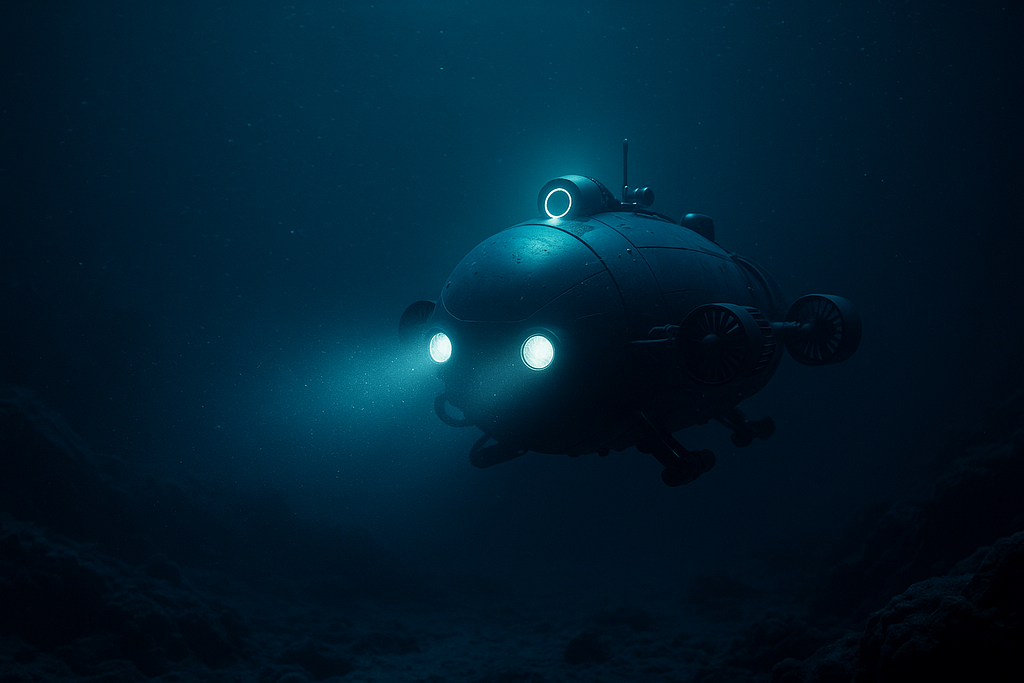Beneath Pressure- Why Underwater Robotics Is the Final Engineering Frontier
“Water is more hostile than space in many ways. You don’t just need to survive — you need to maneuver, perceive, and think while drowning in darkness.”
— Dr. Sylvia Earle, Oceanographer
🌊 Introduction: When Water Feels More Alien Than Space
The robotics domain has rapidly advanced in air, land, and even in orbit — but one realm remains notably underdeveloped: the deep sea. Underwater robotics presents a unique and daunting challenge that has kept many technologists at bay.
The major bottleneck? Energy and material limitations in a high-density environment. The buoyant force might reduce weight, but not inertia. Water is 800 times denser than air, demanding not just more energy to move, but radically different design principles, actuation strategies, and sensing systems.
Let’s take a step back and ask:
What if we looked at the relationship between water and air the way we view air and vacuum (space)?
If space is devoid of matter, air is the medium we’re used to, and water is something in between — then designing for underwater environments should be as radically different from air as space exploration is.
🚀 The Analogy That Changes Everything
Let’s break this down:
Domain Medium Key Challenge Vacuum (Space) No medium Temperature, pressure, propulsion Air Light medium Friction, lift, gravity Water Dense medium Drag, pressure, turbidity, inertia
We’ve built planes for air and satellites for space. But treating water as “just a denser air” has failed us. What’s missing is the paradigm shift — just as space systems evolved radically from aircraft, underwater systems need an equally independent design philosophy.
“The ocean is a foreign world just 100 meters below — it needs its own engineering ecosystem.” — Dr. Robert Ballard, Discoverer of Titanic wreck
⚙️ Designing for Water: The Anti-Analogy
In aerospace, we think lightweight materials, high velocity, and fuel efficiency. In underwater robotics, those assumptions break down.
Key Design Shifts:
- Pressure resistance dominates weight saving — titanium replaces carbon fiber.
- Propulsion by thrust isn’t optimal — low-RPM, high-torque thrusters with vectoring are better.
- Vision is unreliable — sonar, acoustic, and magnetic sensing become primary.
- Wireless communication fails — RF waves don’t travel well; acoustic comms become standard.
🔋 The Energy Equation: Drag + Depth = Demands
Moving through water requires exponentially more energy due to fluid resistance. At depth, you face crushing hydrostatic pressure — approx. 1 atmosphere per 10 meters. That means a 1000-meter dive exposes your craft to 100x atmospheric pressure — enough to collapse steel.
To operate autonomously, your robot must:
- Overcome drag continuously
- Run localization, mapping, and AI inference onboard
- Power lighting, sensors, and actuators in real-time
- Communicate intermittently without surfacing
“AUVs are a power budget puzzle — you’re not just balancing consumption, you’re betting on survival.”
— Naval Research Lab, Underwater Autonomy Division
🤖 The Autonomous ROV: Not Just a Drone, a Deep Thinker
With advances in AI and embedded computing (Jetson Orin Nano, Coral TPU), modern underwater robots can now “think” locally:
- Detect objects (e.g., mines, coral damage, plastic waste) using YOLOv8 under turbidity-augmented datasets
- Perform SLAM using sonar and optical fusion (when possible)
- Make path planning decisions with onboard autonomy to avoid re-surfacing
In my own project, I’m building an underwater ROV that applies this philosophy. Inspired by both robotics research and nature, I’m combining:
- A ROS 2-based control stack
- A suite of sensors: IMU, stereo camera, depth sensor, acoustic rangefinder
- Adaptive center-of-gravity control for pitch/roll management
- AI-based object recognition to detect patterns in coral health and debris clusters
📡 Reinventing Perception: Eyes That Hear
Underwater, light fades quickly. Vision-based systems suffer from:
- Color distortion (reds disappear first)
- Low visibility (due to particles)
- Non-uniform lighting
Hence, the shift is toward:
- Sonar imaging
- Structured light scanning
- Magnetic anomaly detection
Emerging approaches like self-supervised learning from sonar and Doppler velocity logs are showing great promise in murky or deep environments.
“Underwater vision doesn’t mean seeing like a human — it means perceiving like a fish with sonar, pressure, and flow awareness.” — MIT SeaPerch Research Team
🐠 Nature’s Way: Lessons from Biomimicry
Some of the best underwater robots today mimic:
- Squids and jellyfish (for propulsion)
- Crabs and lobsters (for seabed movement)
- Fish (for active flow sensing)
Projects like Festo’s AquaRay, MIT’s Soft Swimming Robot, ETH Zurich’s Ecoleg®… have proven that biomimicry isn’t just artistic — it’s energy-efficient and stealth-friendly.
🧭 Where Are We Heading? The 2030 Underwater Vision
The robotics industry, governments, and startups are investing in:
1. Modular Underwater Swarms
- Collaborative mapping & exploration
- Ocean carbon stock analysis
- Disaster response (e.g., tsunami debris tracking)
2. Persistent Deep-Sea Observatories
- Robots parked at seafloor for years, powered by seabed thermal gradients
- AI manages sensor prioritization and event-triggered alerts
3. Marine Security & Sovereignty Bots
- Real-time anomaly detection across national maritime zones
- AI identifies illegal fishing, oil leaks, or enemy craft
Conclusion: We Must Unlearn What We Know
If we truly wish to unlock the ocean’s potential — for sustainability, security, or discovery — we must stop thinking in terms of “land or air robots going underwater.”
We need a revolution in design, perception, energy, and autonomy — not an adaptation, but a reinvention.
“The sea, once it casts its spell, holds one in its net of wonder forever.” — Jacques Cousteau
✊ Call to Action:
To entrepreneurs, researchers, and policy-makers:
Let’s treat the underwater domain with the same seriousness, funding, and innovation intensity as we do for space. The oceans are not just Earth’s lungs — they’re its nervous system. And it’s time our robots learned to swim.
Want to Collaborate?
If you’re working in underwater autonomy, marine AI, or embedded perception, I’d love to collaborate. Drop a message or email — let’s bring the next generation of intelligent ROVs to life.
Author: Anand Vardhan (anandvk113@gmail.com)

